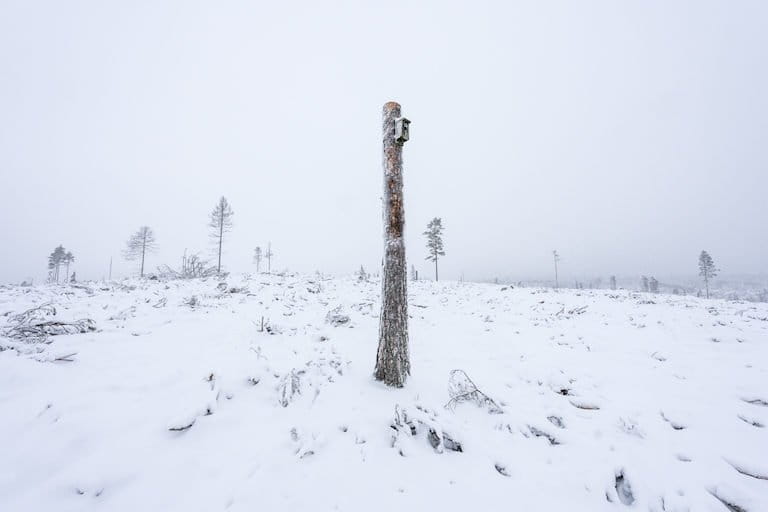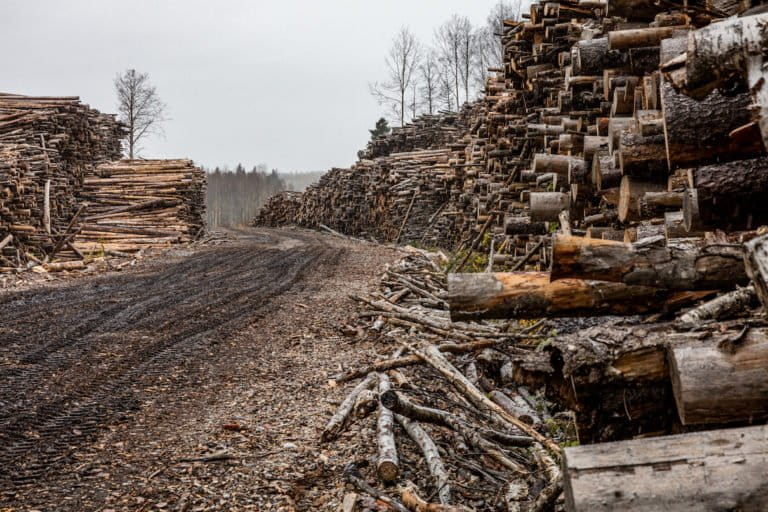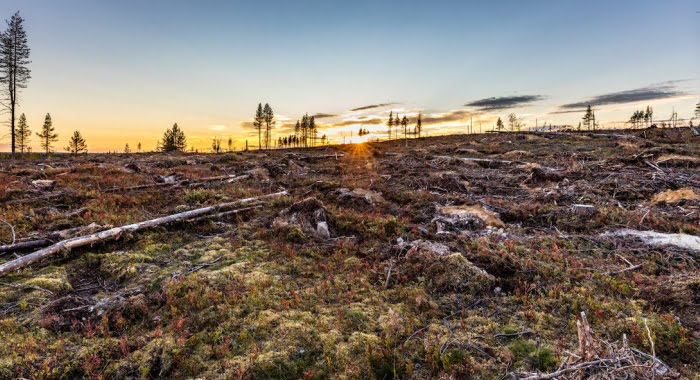It's easy to imagine that Sweden, and it's enlightened population, are world leaders when it comes to all things environmental and sustainable. When it comes to their huge forestry industry that isn't exactly the case though.
Erik Hoffner, in an article for Mongabay, discussed the sustainability of Swedish forestry with Marcus Westberg and Staffan Widstrand.
Over a decade ago I traveled around Sweden to view its forestry practices – the country has a gigantic forest products industry that largely transforms trees into paper products and biomass pellets for electricity generation – yet the national forestry agency claimed it to be the most sustainable forestry program in the world. What I found was strikingly different, as I reported for Yale Environment 360, “Sweden’s Green Veneer Hides Unsustainable Logging Practices.”
I wanted to know what has changed since 2011, and queried two Swedes who are very involved with this ongoing issue: award-winning photojournalist Marcus Westberg and top conservation photographer/National Geographic Explorer Staffan Widstrand, who are active under the banner of Skogsmisbruket, i.e. ‘forest abuse,’ an awareness raising project on Swedish forestry.
They collaborated on their responses via email, which have been lightly edited for accuracy and brevity.
Mongabay: Can you say what Sweden’s forestry model is and why that has led to logging of its very old boreal forests, and their replanting with monocultures of trees?
Marcus Westberg and Staffan Widstrand: Sweden’s approach is both devastating and devastatingly simple: treat forests like agricultural fields. Harvest whatever is there, plough the ground, plant new tree plants, and repeat, hopefully. These plantations are highly effective if what you want only is to produce large volumes of low-quality wood, and provided that these plantations survive until harvesting age. Which is not a given, since they are very susceptible to bark beetles, moose browsing, fungus attacks, drought, storm and fire. It is a high-risk gamble, but the industry really only cares about what they can harvest today: eventual harvest 80-100 years later is somebody else’s problem.

Another problem is that there isn’t much point in harvesting a 30-year-old plantation, and the clearcutting approach to forestry began in earnest in the 1950s. Luckily for the forestry industry, Sweden has – or rather, had – plenty of natural forests. As Sweden clearcuts close to 1% of its forests every year, and almost all plantations are too young to harvest – well, that only leaves you with one source, the old, natural forest. And that is disappearing very, very quickly.
Yet another problem is that the Swedish forestry model also consists of something that roughly translates to “freedom with responsibility,” which was introduced in 1993. As a landowner, you are expected to show greater consideration regarding ecological and social values than the law requires. Most of the time, unfortunately, that simply doesn’t happen. Only 3% of Sweden’s forestry doesn’t involve clearcutting, according to a 2021 government report. That should be pretty shocking to anyone who hears it, given Sweden’s reputation as a leader of so-called green practices.
Mongabay: The logging industry is dominated by very large companies, one state-owned and one owned by the Church of Sweden, plus many private ones, most of which are FSC-certified. Do these companies comply with FSC rules and does that improve conservation measures?
Marcus Westberg: FSC is, unfortunately, largely a marketing gimmick. It is a very corrupt system with extremely low credibility. A big part of the problem is that the companies are free to choose their certifiers. A while back, Sveaskog received a warning from theirs, DNVLG – a so-called ‘red card.’ Instead of heeding the warning, they quickly switched to Bureau Veritas, who promptly removed the red card and let Sveaskog continue with business as usual. This is the core of a corrupt system. As around two-thirds of Sweden’s forest area is FSC certified, but then only a tiny fraction of planned forestry operations are ever inspected… Well, I’ve seen for myself how FSC-certified logging companies clearcut trees that are hundreds of years old.
It should be noted, I suppose, that FSC doesn’t actually claim that their certification guarantees ‘sustainable’ forestry. The word they use is ‘responsible.’ To whom? Still, the fact that no Swedish forestry company has ever lost its FSC certification despite the complete destruction of entire ecosystems doesn’t exactly suggest that it’s particularly reliable.

Mongabay: What do Swedes think about this? My own reporting showed that average citizens believed industry rhetoric that theirs is the greenest forestry program in the world, while forest activists disagreed, whose side are the facts on?
Marcus Westberg and Staffan Widstrand: We would say that this was truer two years ago than it is today, though it’s still a huge issue. There has been a tidal wave of devastating revelations about conflicts of interest, corruption, and other scandals published in Swedish mainstream media, from newspapers to state-owned television, as well as a growing engagement in this question by various Swedish conservation NGOs. So, more people are aware of what’s going on, though the industry and its political puppets make it a pretty uneven struggle.
As for the facts, there is no serious debate. Our forestry industry making claims about sustainability is like the oil industry denying climate change or, back in the day, the tobacco industry pretending that there was no link between smoking and cancer. There is nothing green or sustainable about Swedish forestry. The ecosystems it destroys would take a thousand years to fully recover.
Investigative journalist Lisa Röstlund has done some incredible reporting about all this for Dagens Nyheter, Sweden’s most important newspaper, and just released a new book on the subject, Skogslandet. I hope it gets published in English, because we need the world to know.
Most Swedes have never seen a proper old-growth forest, and most have not seen the huge clearcutting areas yet. So, we decided to show these to the world.
Mongabay: Is sentiment in rural areas now turning, too? I read what hundreds of forest owners wrote last year that they want a new forest policy that would revitalize the countryside, producing long-lasting products instead of paper products, and promote forest tourism & non-timber forest products like berries & mushrooms.
Marcus Westberg and Staffan Widstrand: The easy answer is that hardly anybody likes to live next to a clearcut, regardless of what they think about forestry in general. Part of the problem in the past has been that the forestry industry managed to convince small-scale forest owners that they were on the same side, and that conservationists were the enemy who wanted to destroy their livelihoods. In truth, conservationists, small-holding forest owners, and rural residents make far more natural allies.
The forest industry is inseparable from the paper and biofuel industries – it’s often the same companies – and all they want is large volumes, as cheaply as possible. Forest owners would benefit more from the opposite: selling less wood, but at a higher price. Timber prices in Sweden are artificially low, since the government, through its state-owned forestry company, Sveaskog, dumps the prices as soon as timber prices tend to go up. Then Sveaskog logs huge volumes, even at a loss, just to swamp the market and bring prices down.
Swedish timber prices are about 50% lower than in our neighboring countries. More and more people are beginning to reason exactly that way. Hence the letter you mentioned. For forest owners to speak up – well, that’s exactly what we need. However, for landowners to be able to protect their forests, we also need financial incentives. Serious government compensation for conserving productive forests. At the moment, that’s not happening. Rather than encourage landowners to protect their forests, the only thing that’s facilitated is large-scale logging for short-term profit.

Mongabay: The industry has countered all this pushback by claiming that not only are its cutting of old growth forests and replanting with tree monocultures ‘green,’ but that they’re also carbon neutral, and I’ve even seen them claim their activities are carbon negative. How do you understand their math in this regard?
Marcus Westberg and Staffan Widstrand: Their math is bogus. For one thing, more than three-quarters of Swedish wood becomes single-use or short-life products, such as paper or biofuel, which means the carbon is released into the atmosphere shortly. Two, most of the carbon stored by boreal forests is found underground, in a symbiotic relationship between tree root systems and fungi. Killing all the trees in one area means killing all the root systems and the mycorrhizal fungi, which are ancient and in huge volume in the ground. That killing, plus churning up the soil so you can plant new trees, means all that carbon will get released, too. However, this is never accounted for in the official statistics. So, about half of the greenhouse gas emissions from clearcutting forestry are not even measured.
Three, it takes decades for newly planted trees to absorb anything like the amount of carbon previously held by larger, older trees, and their underground root and fungi systems. Having more trees is great, but not if it is done at the expense of existing forests. Short term, it’s a catastrophe, also CO2-wise.
Finally, in their calculations, the industry then counts the carbon absorbed by all of Sweden’s tree-covered areas in their plus column. Since the logging is at about 100% growth capacity, virtually all carbon sequestration by trees in Sweden is now done only in the protected areas. The industry is essentially arguing that even if their emissions are the largest of any industry in the country – and they are – it doesn’t matter, because the trees that they don’t log absorb enough greenhouse gases to compensate for the emissions…
Mongabay: Sweden has received a fair amount of criticism from the EU recently. What’s that about?
Marcus Westberg and Staffan Widstrand: Well, the European Commission is attempting to limit deforestation by blocking products that destroy forests from the EU market. It would require companies selling, for example, coffee, palm oil, beef, or wood to police their supply chains. Who could possibly object to that?
You won’t be surprised to hear that Sweden can, and does, alongside Finland and the Baltic states. You see, this would require the EU member states to meet the same requirements, and the inclusion of wood on that list is a massive threat to them. Sweden argues that the proposal should only target large-scale deforestation, which, according to their own definition, they don’t contribute to. Finland, meanwhile, has suggested that each country should be able to define what forest degradation – another term used in the proposal – ought to mean.
Essentially, by blocking this proposal, Sweden, Finland, and the others are ensuring that products directly linked to the destruction of the Amazon can continue to be sold in Europe. All so they don’t have to stop clearcutting their own forests.
Mongabay: Among several recent controversies, one involved the head of the Swedish Forestry Agency. What was that about?
Marcus Westberg and Staffan Widstrand: The Swedish Forestry Agency, as a government agency, is theoretically meant to be neutral. However, the fact that its head, Herman Sundqvist, is a former Director of Forestry at the state-owned forestry company, Sveaskog, should ring a few warning bells, but that’s old news.
The first thing that happened in late 2021 was the discovery that Sundqvist himself owns around €3 million worth of productive forest. That might just be a conflict of interest, especially since he bought a large part of that after he was hired for the job.
The real scandal, however, was that he had been in contact with forestry industry lobbyists using his private email, allegedly passing on warnings and suggestions to help them weather the ongoing media storm. When asked to share these emails, he simply deleted them, which is illegal. This saga is still being played out, but that he somehow manages to keep his job shows that the corruption is clearly even worse than many of us might have thought.
Mongabay: Greenpeace filed a lawsuit late last year challenging FSC certification of Sveaskog over violations of Sami rights. How does the Swedish forestry industry treat the Indigenous Sami people whose livelihoods rely on northern forests, in which their reindeer forage during the long winters?
See related: EU Environment Committee urges scaling back of biomass energy

Marcus Westberg and Staffan Widstrand: Very poorly. Reindeer rely on lichen-rich forests. That only means old forests. Unfortunately, those are the very forests targeted by forestry companies, for the simple reason that they have clearcut everything else and are not allowed to harvest trees under 60-80 years old. It’s hard to overstate just how brutal Sweden’s forestry industry is. We’ve lost over three-quarters of what might be called our old growth forests since the 1950s. There aren’t many pockets of relatively intact forest ecosystems left, and these are coming down at a terrifying speed as we speak. The Sami are protesting vividly, but the politicians and industry simply ignore them.
Back to the Sami, it’s worth noting that the Council of Europe’s Committee of Ministers, which is composed of the foreign ministers of the 46 member nations, published a resolution sharply criticizing Sweden’s treatment of the Sami a few years ago. It specifically encouraged Sweden to immediately strengthen the possibilities for the Sami to engage in their cultural practices – reindeer herding – on their traditional land. Essentially, to stop logging the forests their reindeer need to survive. How well Sweden has followed through on this will be assessed this coming summer, but we already know the answer.
An even more painful part is that most of the clearcut logging on Sami land is carried out by Sveaskog, and often at a direct loss. So we can say that the Swedish taxpayer is actually continuously subsidizing the deforestation of Sami lands, for the good only of the privately-owned industry giants.
It’s a disaster for the Sami, biodiversity, the countryside’s development, the small-holding land owners, and the nature tourism industry.
Mongabay: What else should readers know about forestry in Sweden?
Staffan Widstrand: That it is not sustainable at all. It is by far our single-most, largest source of emissions of greenhouse gases to the atmosphere. ‘Biofuel from the forest’ is a total scam, not ‘green’ at all, and instead adds even more CO2 to the atmosphere, just at a time when we need to stop all burning of things. The clearcutting industry and the forestry industry, taken together, in reality emits more CO2 to the atmosphere than all other industries – transportation and all other human activities taken together – in Sweden.
See more of these photographers’ images and thoughts at Instagram via @marcuswestbergphotography and @staffanwidstrand. Skogsmisbruket is also active there, via @skogsmissbruket.
You can also watch the recent film “More of Everything” to learn more about these issues:
This article is republished from Mongabay under a Creative Commons license.
